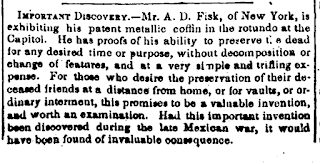John L. Wirt and A. D. Fisk are described in Dolley Madison's papers
Posted by Cunningb2 | Posted in Dolley Madison - First Lady , Fisk's Caskets , Wirt | Posted on September 05, 2020
Wirt, John L. (1811–1857)
A policeman and civil servant, in 1849 John L. Wirt was a member of the Capitol Police. He went on to be elected a city Alderman, in which office he served four years. He was also an assistant funeral director, working with and for Mathias M. White, who sold the Fisk coffins (in one of which DPM was buried). Wirt died in 1857, not yet 50 years old, from a “hemorrhage of the lungs,” and was buried in Congressional Cemetery. In 1837 he married Margaret Rebecca Duley Wirt, who lived only two years more than her husband.
~~~~
Fisk, Almond Dunbar (1818–1850)
An entrepreneur and inventor, Almond D. Fisk was the son of Catherine Worthington and Solomon Fisk. In 1848, Fisk patented an improvement in the manufacture of coffins. “What I claim therein as new,” Fisk wrote in his patent, “is the manufacturing of coffins of cast or raised metal when made... to the human form.” Molded in two equal parts, the cases “united horizontally.” From these coffins, “the air may be exhausted so completely as entirely to prevent the decay of the contained body on principles well understood.” Thus the body was sealed in a sarcophagus that would preserve the deceased’s remains and prevent the spread of disease and, theoretically, putrefaction.
Due to high demand, Fisk partnered with his brother-in-law, William Raymond, and opened a foundry in New York to manufacture the coffins shortly after receiving his patent. John Payne Todd apparently viewed one of his coffins on display in Washington City in the spring of 1849. A few weeks later, Fisk wrote DPM about the possibility of reinterring JM in one of his coffins. It is unknown what DPM thought of that idea, but when she died that summer, she was interred in one of Fisk’s new coffins.
In 1840 Fisk married Phoebe Ann Raymond, with whom he had five children. In the fall of 1849 Fisk’s foundry was leveled by fire. Shortly thereafter, Fisk fell ill and died in the fall of 1850.
First quotation is from Fisk, Almond D., inventor; “Improvement in Coffins” U.S. Patent 5,920. November 14, 1848; second quotation, Daily National Intelligencer, 18 October 1850.
























































